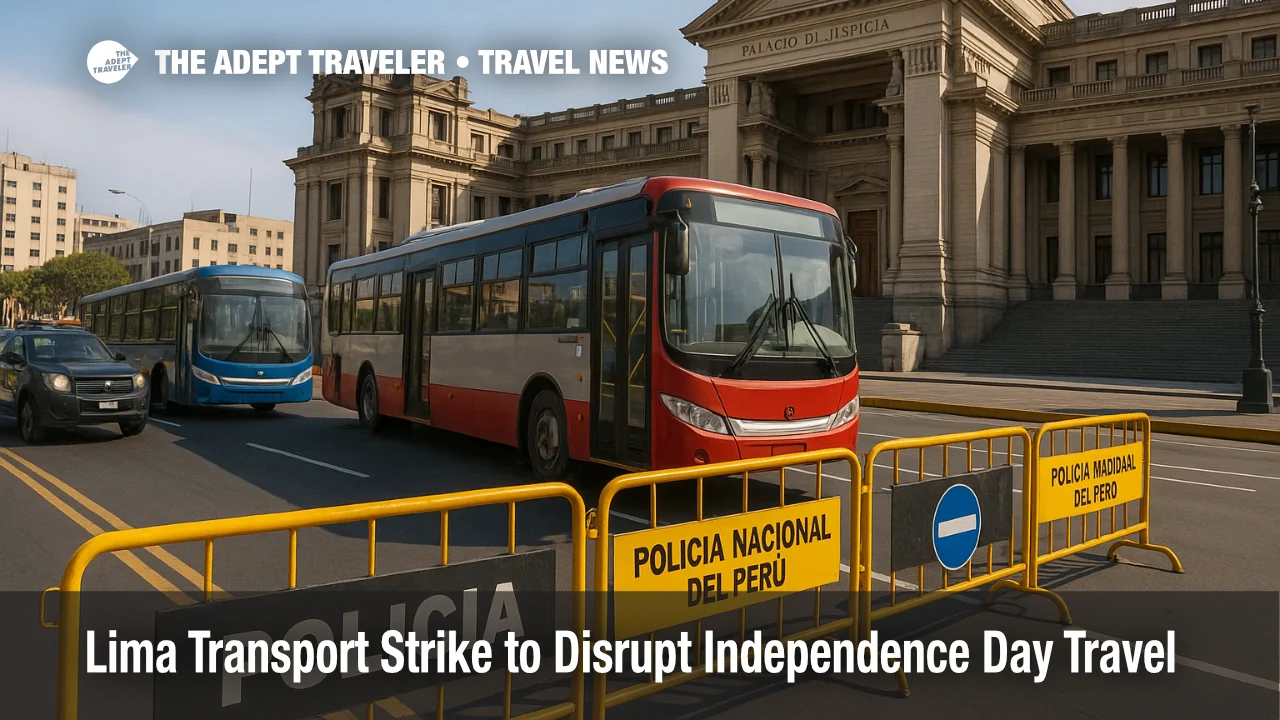Lima Transport Strike to Disrupt Independence Day Travel

Travelers bound for Peru at the end of July could face widespread disruption as Lima's largest transport unions stage a three-day strike beginning Friday, July 26, 2025. The walkout coincides with the city's Independence Day celebrations and is expected to culminate in a massive march from the Palace of Justice to the historic center on Sunday, July 28. Roadblocks, reduced bus schedules, and sporadic closures of the airport expressways are likely, prompting airlines and hotels to warn visitors to build extra transit time.
Key Points
- Why it matters: Roadblocks and bus shortages could stall transit between Jorge Chávez International Airport and downtown Lima.
- Three-day strike runs July 26-28, peaking with Palace of Justice rally on July 27.
- Limited Metropolitano and city bus service; taxis expect heavy demand and surge pricing.
- Airport expressway closures may delay flights by 60-90 minutes during peak protest windows.
Snapshot
Union leaders from the Alianza Nacional de Transportistas and the Asociación Nacional de Conductores have called for a "total stoppage" to protest rising extortion, fuel costs, and stalled safety reforms. The action begins with rolling roadblocks on July 26, intensifies around the Palace of Justice on July 27, and concludes with a city-center march on July 28, Peru's Independence Day. Authorities have authorized 3,000 police officers to guard key arteries, while the airport concessionaire LAP warns that the Vía Expresa Elmer Faucett and Vía Expresa Lineal could close without notice. Airlines are granting no-fee rebooking for flights on the affected dates.
Background
Transport walkouts have become more frequent in Lima since April 2025, when drivers first protested a spike in violent robberies targeting buses and combis. Subsequent one-day stoppages in May and June drew up to 7,000 vehicles off the road and forced schools to shift online. Unions argue the government's promise of beefed-up policing has not materialized, citing more than 500 driver deaths in the past year. Independence Day, known locally as Fiestas Patrias, typically draws large patriotic marches and military parades, so organizers hope pairing their strike with the holiday will maximize public pressure on President Dina Boluarte. The administration, for its part, has labeled the action "politically motivated" and urged dialogue.
Latest Developments
Strike schedule and protest hotspots
Union spokespeople confirm that informal roadblocks will start at dawn on Friday, July 26, mainly along Avenida Abancay and the Pan-American Highway. Saturday, July 27, brings the largest gathering: protesters will converge on the Palace of Justice at 10 a.m. and hold a rally until late afternoon before dispersing toward Congress. On Sunday, July 28, the route shifts to the Plaza de Armas, overlapping with the official military parade and Independence-Day flyover. Lima's municipal government has issued detour maps and urged residents to avoid the Cercado de Lima district. Ride-hail platforms have already flagged possible dynamic-pricing spikes of up to 200 percent, while intercity buses from the Cruz del Sur and Oltursa terminals have announced schedule cuts of 30 percent. Travelers connecting through Jorge Chávez should allow an extra 90 minutes for security and traffic screening.
Analysis
For international visitors, the timing of the strike creates a perfect storm. July 26 marks the start of Peru's long holiday weekend, when domestic vacationers traditionally flock to Lima's coastal resorts or fly to Cusco. Pulling thousands of city buses, combis, and informal colectivos off the streets will hit lower-cost ground transport hardest, forcing many locals onto ride-hail apps and stretching the supply of registered taxis. That, in turn, could create bidding wars for airport pickups, pushing fares beyond what budget travelers anticipate. On the aviation side, Jorge Chávez lacks a dedicated rail link, so any closure of the Vía Expresa bottlenecks all access roads, risking missed connections for onward flights to Arequipa, Iquitos, and international hubs such as Miami and Madrid. The civil-aviation authority's decision to waive rebooking fees is helpful, yet carriers can only re-accommodate so many passengers once high-season loads approach capacity. Hotels in Miraflores and San Isidro are bracing for late check-ins and have staffed extra concierges to assist with rerouted guests. If street clashes occur, a precedent set in April shows authorities may order remote work, which would thin commuter traffic but also shutter some tourist-facing businesses. Savvy travelers should therefore keep flexible plans, monitor official advisories, and favor accommodations that can arrange private transfers on short notice.
Final Thoughts
With patriotic fervor and labor frustration converging, Lima's streets are poised for three days of congestion and protest theater. Anyone arriving or departing between July 26 and July 28 should lock in transport alternatives now, track live traffic feeds, and expect unplanned detours. A little advance planning will go a long way toward minimizing headaches during the Lima transport strike.
